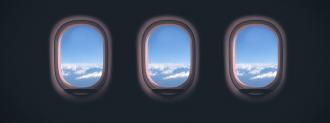Traditionally, summer is the busiest season for air travel, but passenger traffic is currently down 75% at U.S. airports due to COVID-19.
However, that means that more than 600,000 people are still flying during the coronavirus pandemic daily. If you’re considering joining them, here’s what you need to know to do so as safely as possible.
Flying During the Coronavirus Pandemic
First things first: flying right now is likely to increase your risk of catching and spreading COVID-19.
“Air travel requires spending time in security lines and airport terminals, which can bring you in close contact with other people and frequently touched surfaces,” the CDC warns.
“(S)ocial distancing is difficult on crowded flights, and you may have to sit near others (within 6 feet), sometimes for hours,” it added.
The first thing you’ll want to do, then, is consider your reason for flying during the coronavirus pandemic. Is the purpose of your trip worth the risk to your health?
“We should all be in the mindset of ‘only if necessary,'” Lauren Ancel Meyers, an expert in disease outbreaks at the University of Texas, told the Associated Press with regards to traveling during COVID-19.
When weighing the risk, also take into account your destination — flying into a bigger city with a lot of COVID-19 cases is likely riskier than visiting a smaller one with fewer cases.
Booking Your Flight
If you decide flying during the coronavirus pandemic is worth the risk, the next step is buying your ticket — and at that point, you’ll want to do your research.
Most airlines in the U.S. have made at least some changes to the way they do business in response to the coronavirus pandemic.
Many — but not all — stopped selling tickets for middle seats in an attempt at social distancing. However, despite the nation’s case numbers still soaring, American Airlines began attempting to book to full capacity again on July 1.
We should all be in the mindset of ‘only if necessary.’
Lauren Ancel Meyers
In addition to considering an airline’s in-flight social distancing effort, you’ll also want to research their other coronavirus policies, which are likely easy to find on their website. How are they cleaning plane interiors between flights? Are they screening patients for COVID-19 symptoms?
Read about other travelers’ experiences flying during the coronavirus pandemic. Was the airline they used enforcing face mask policies? Overbooking flights?
Look into the airline’s current change and cancellation policies, too, in case developments in the pandemic prompt you to rethink your trip — The Points Guy maintains a regularly updated list of these.
Taking Safety Into Your Own Hands
While it’ll be on the airline to mitigate many of the risks associated with flying during the coronavirus pandemic, there are things you can do yourself to decrease your chances of catching COVID-19.
When you book your ticket, opt for a window seat if possible — it’ll keep you at least slightly farther away from people walking along the aisle during the flight — and instead of checking in at the airport counter, do so online.
If you have to check a bag, consider using a curbside service, if available, instead of waiting in line with other passengers. Before going through security, put as many of your belongings in a carry-on as you can — you’ll want to avoid using the bins as they’re high-touch items.
Bring plenty of hand sanitizer — TSA will let you carry 12 ounce bottles through security now — and any snacks you’ll want for the flight so you don’t have to buy them at the airport.
Wash your hands regularly and use wipes to disinfect your seat before settling in for the flight. Once in your seat, open the air vent above your head and point it toward you.
“The air in the plane blower has been filtrated, which can remove more than 99% of dust and microbes in the air,” Jonathan Fielding, a professor of public health and pediatrics at UCLA, told NBC New York.
“By having the vent blow on you,” he continued, “you create an invisible air barrier around you that creates turbulence — simultaneously blocking any droplets that may have viruses within them and forcing them down to the ground.”
Finally, wear a face mask as much as possible while traveling during COVID-19 — only take it off if you need to for security checks or to eat and drink.
We’d love to hear from you! If you have a comment about this article or if you have a tip for a future Freethink story, please email us at [email protected].






